Traditional Moravian Sugar Cake with Idaho® Potatoes
Moravian Sugar Cake is a treat you may not have heard of outside of parts of North Carolina and Pennsylvania, where the Moravians settled. I was fortunate to grow up in Charlotte, NC, only a couple of hours from the hotbed of Moravian Sugar Cake activity in North Carolina: Winston-Salem.
Traditionally served at both Easter and Christmas, we only ever enjoyed them at Christmas, which is why I am so excited to bring you this recipe as we approach the holidays. Soft, pillowy potato sweet dough spread into pans, allowed to rise, and then poked with holes. Not dimples as in a focaccia, but holes all the way through. They’re there so the butter-brown sugar-cinnamon topping can find it’s way to the bottom of the cake and caramelize.
Perfect warm--not hot--from the oven, or see the recipe notes for tips on how Moravians reheat their Moravian Sugar Cake for serving.
This recipe makes 2 thick 9 x 13” Moravian Sugar Cakes or 2 thin 13 x 18” cakes. Or one of each. Enjoy.
Ingredients:
For the Dough:
- 8 oz (1 packed cup) mashed potato (Idaho® russet potato cooked in lightly salted water)
- ½ cup water from cooking the potatoes
- 1 cup whole milk, warm but not hot
- 1 1/2 teaspoons kosher salt (I use Morton’s)
- ⅓ cup granulated sugar
- 4 oz melted butter
- 2 large eggs
- 32 oz (2 pounds) all purpose flour (I use Gold Medal)
- 2 teaspoons dry yeast
For the Topping:
- 2 sticks unsalted butter, melted
- 2 packed cups light brown sugar, divided
- 2 teaspoons ground cinnamon
Directions:
For the Dough:
- Place the warm mashed potatoes in the bowl of your stand mixer.
- Add the potato water, milk, salt, and sugar.
- Fit your mixer with the paddle attachment and mix on medium low speed until the potato mixture is smooth.
- Mix in the melted butter and the eggs.
- Add all the flour on top of the potato mixture followed by the yeast.
- Knead on medium speed for about 15 minutes, until the dough is smooth, shiny, stretchy and clears the sides of the mixer bowl. The dough is very soft and will stick on the sides and in the bottom of the mixer bowl. After several minutes of kneading, it should only stick in the bottom.
- Scrape the dough into a rough ball in the mixer bowl, spray with a bit of oil or pan spray, cover and refrigerate for 8-12 hours.
For the Topping:
Whisk the brown sugar and cinnamon together thoroughly. Divide in half.
To Finish and Bake:
- Remove the dough from the refrigerator, and split the dough in two equal parts. If you have a scale, weigh the entire mass and divide by two to make sure you have even halves.
- Line 2 9 x 13” or 13 x 9” pans (or one of each) with parchment, allowing the two short sides to extend over the edges of the pan..
- Divide the dough into two equal parts.
- Place each piece of dough in each pan, and then use your hands to press the dough out to completely fill each pan. Your dough will be about ½” thick in the 9 x 13” and about ¼” thick in the 13 x 18”. It might take awhile to work the dough into all the corners, but I promise it can be cone.
- Spray the tops of both cakes with pan spray, and cover. Let rise in a warm place until doubled. This could take up to 3-4 hours, depending on the temperature of your kitchen..
- Once the dough has risen well, take them out and make holes with your fingertips all the way through the dough. Space the holes maybe an inch to an inch and a half apart.
- Sprinkle one half of the brown sugar, cinnamon mixture over each cake. Then the melted butter evenly over the cakes, one stick per cake.
- Cover and let rise an additional 30-45 minutes until puffy. Heat the oven to 400F and position racks in the top and bottom thirds of the oven.
- Bake 12-15 minutes for the 13 x 18” cakes and 20-22 minutes for the 9 x 13” cakes. Rotate the pans and racks halfway through baking.
- Once the cakes are done, run a thin spatula along the long sides of the pan to make sure there was no sticking. Allow to cool in the pans for 15 minutes, and then use the parchment to help lift the cakes out of the pans. Allow to cool to warm before serving, or cool completely and reheat to serve. (See Notes)
Notes:
You can absolutely divide this recipe in half if you don’t want quite so much Moravian Sugar Cake. If you do make the whole recipe, a 5-quart stand mixer will get the job done, but a 6-quart mixer would work better.
To reheat Moravian Sugar Cake, you can put it in the microwave for a few seconds or place it, wrapped in foil, in a moderate oven. But the traditional way to reheat it is to fry it in a skillet with a good amount of butter.





